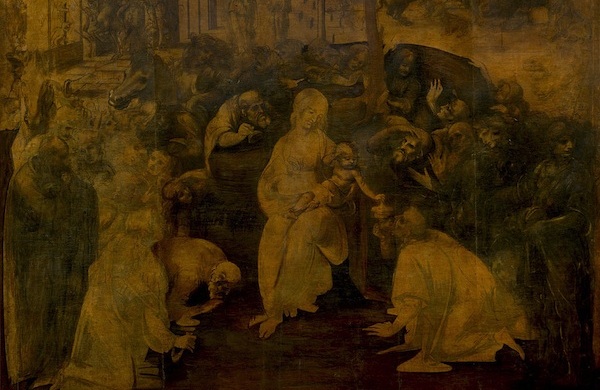
The painting was in rough shape when it arrived at Florence’s Uffizi Gallery. The townspeople and horses surrounding the Virgin Mary and her infant child sank into a swamp of murky browns, oppressed by centuries of added varnish; other areas hadn’t been painted at all when work on the piece had stopped. Chunks of wood had been ripped off the top, and the back bore water damage.
But the delicate, unnervingly lifelike lines of The Adoration of the Magi’s figures bore the stamp of Leonardo da Vinci—even if, as art diagnostician Maurizio Seracini eventually concluded, nearly all the paint topping the master’s original lines had been added by a clumsier hand more than a century later.
To Restore, or Not to Restore?
You might think the next order of business upon receiving this masterwork, confirming its authorship, and briefly pretending to be a Renaissance nobleman would be to immediately try to undo the ravages of time. That was the Uffizi’s plan at first. But restoration is by no means universally supported within the art community, and a coalition of scholars quickly formed to protest the gallery’s intentions.
Why wouldn’t you want to restore a piece of artwork? One school of thought, which has been supported by the Louvre in Paris, is that an artwork’s aging process is part of its beauty and should be respected. (The Mona Lisa’s signature coppery background comes from layers of varnish applied atop what were originally bright blue skies, rather than from pollution caused by Florence’s ancient power plants.) Then there’s the unavoidable truth that, no matter how talented, no modern art restorer can be a Leonardo; some scholars worried about overzealous restorers obscuring the artist’s original intentions, as the Magi’s unknown 17th-century over-painter had earlier done.
The Pro-Restoration Argument
Those in favor of restoration, including the National Gallery in London, believe that viewers should be able to see the artist’s original vision, and museums should do whatever they can to make it vividly clear. One of the most famous instances of this effort took place on the Sistine Chapel walls and ceiling, where artists and scientists took on the project of repainting Michelangelo’s frescoes between 1979 and 1999.
As for the Magi, after a decade-long hiatus, preliminary plans for restoration were again underway toward the end of 2012. But the restoration debate may not be quite so fraught for future generations. In addition to advances in art preservation—such as controlling the light, air quality, temperature, and humidity around a piece—more art-documentation projects have popped up to accomplish today what the Magi lovers could not: ask the artist how he or she wants the work treated in the future.








